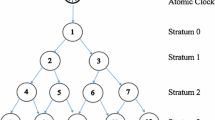Abstract
In this paper, we propose a linear programming-based method suitable for precise and reliable estimation of the skew of a slave clock respective to a master clock using timing information carried over an asynchronous packet network. Solving this problem is key to the viability of deploying low-cost IP-based transport technology in existing GSM networks. The paper is concluded by empirical evidence suggesting that the proposed method indeed has the potential to meet the stringent GSM precision requirements.
Similar content being viewed by others
References
3GPP (2001) Digital cellular telecommunications system (Phase 2+)—Radio subsystem synchronization. Technical Report ETSI TS 145 010 V4.0.0 (2001–2004), European Telecommunications Standards Institute
Aweya J, Montuno DY, Ouellette M and Felske K (2006). Clock recovery based on packet inter-arrival time averaging. Comput Commun 29: 1696–1709
Bi J, Wu Q and Li Z (2006). On estimating clock skew for one-way measurements. Comput Commun 29: 1213–1225
Duda A, Harrus G, Haddad Y, Bernard G (1987) Estimating global time in dsitributed systems. In: Proceedings of the 7th IEEE international conference on distributed computing systems, pp 299–306
Dyers ME (1983). Linear time algorithms for two- and three-variable linear programs. SIAM J Comput 13: 31–45
IEEE (2007) Draft standard for a precision clock synchronization protocol for networked measurement and control systems. Technical Report IEEE P1588/D1-I 2007-04-15, Institute of Electrical and Electronics Engineer
ITU-T (2004) Timing requirements of slave clocks suitable for use as node clocks in synchronization networks. Technical Report ITU-T Recommendation G.812 (06/2004), International Telecommunication Union
Khlifi H and Grégroire J-C (2006). Low complexity offline and online clock skew estimation and removal. Comput Netw 50: 1872–1884
Megiddo N (1983). Linear-time algorithms for linear programs in \({\mathbb{R}}^3\) and related problems SIAM J Comput 12: 759–776
Moon SB, Skelly P, Towsley D (1999) Estimation and removal of clock skew from network delay measurements. In: Proceedings of IEEE INFOCOM, pp 227–234
Mouly M, Pautet M-B (1992) The GSM system for mobile commnunications—a comprehensive overview of the European Digital Cellular Systems. Telecom Publishing
Norros I (1995). On the use of fractional brownian motion in the theory of connectionless networks. IEEE J Sel Areas Commun 13: 953–962
Papagiannaki K, Moon S, Fraleigh C, Thiran P and Diot C (2003). Measurement and analysis of single-hop delay on an IP backbone network. IEEE J Sel Areas Commun 21: 908–921
Paxson V (1998) On calibrating measurements of packet transit times. In: Joint international conference on measurement and modeling of computer systems, pp 11–21
Saporta G (1990) Probabilités, analyse des données et statistiques. Éditions Technip
Wang J, Zhou M and Zhou H (2004). Clock synchronization for internet measurements: a clustering algorithm. Comput Netw 45: 731–741
Zhang L, Liu Z, Xia CH (2002) Clock synchronization algorithms for network measurements. In: Proceedings of IEEE INFOCOM, pp 160–169
Author information
Authors and Affiliations
Corresponding author
Rights and permissions
About this article
Cite this article
Sirdey, R., Maurice, F. A linear programming approach to highly precise clock synchronization over a packet network. 4OR 6, 393–401 (2008). https://doi.org/10.1007/s10288-007-0060-6
Received:
Revised:
Published:
Issue Date:
DOI: https://doi.org/10.1007/s10288-007-0060-6




